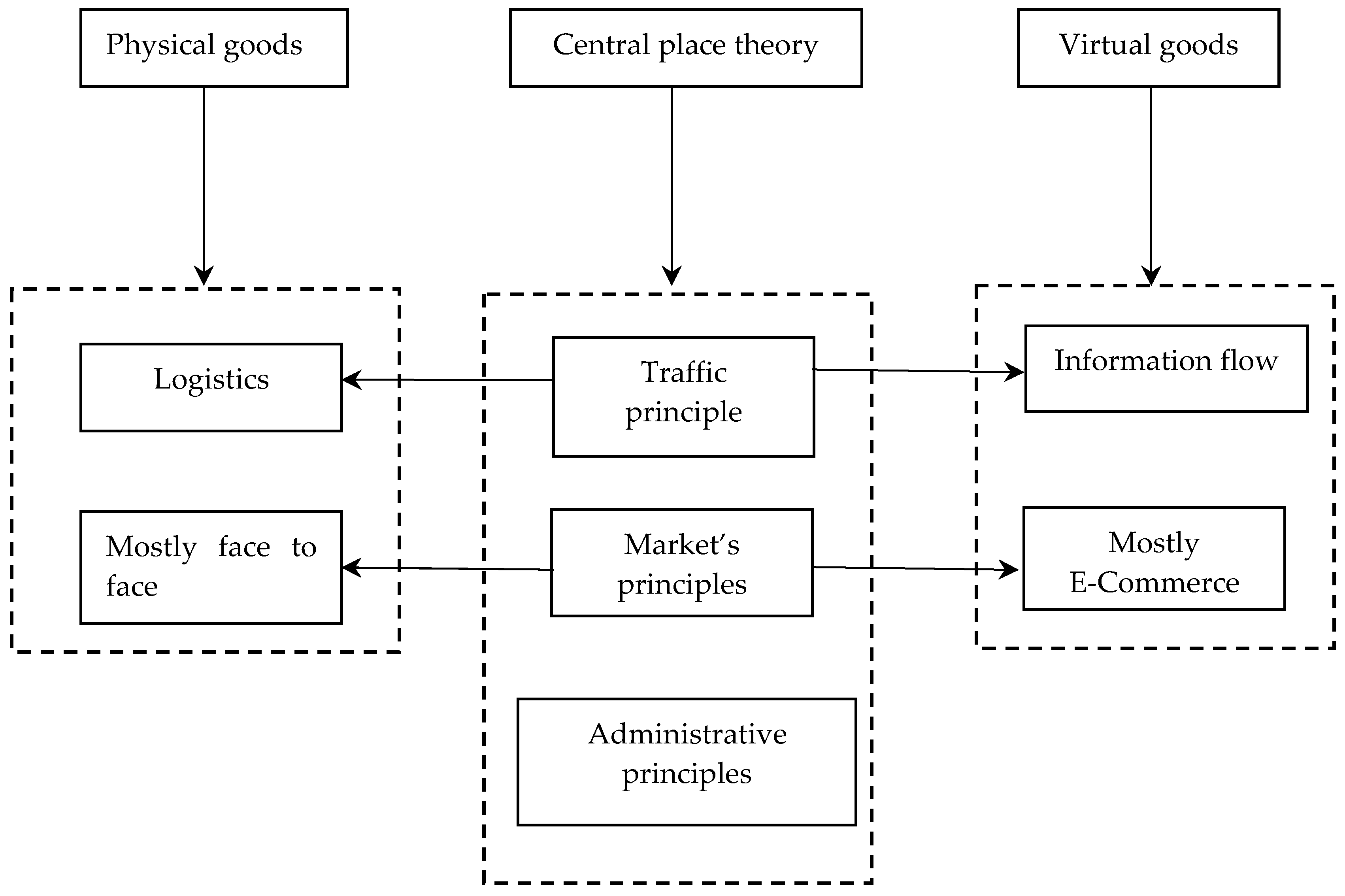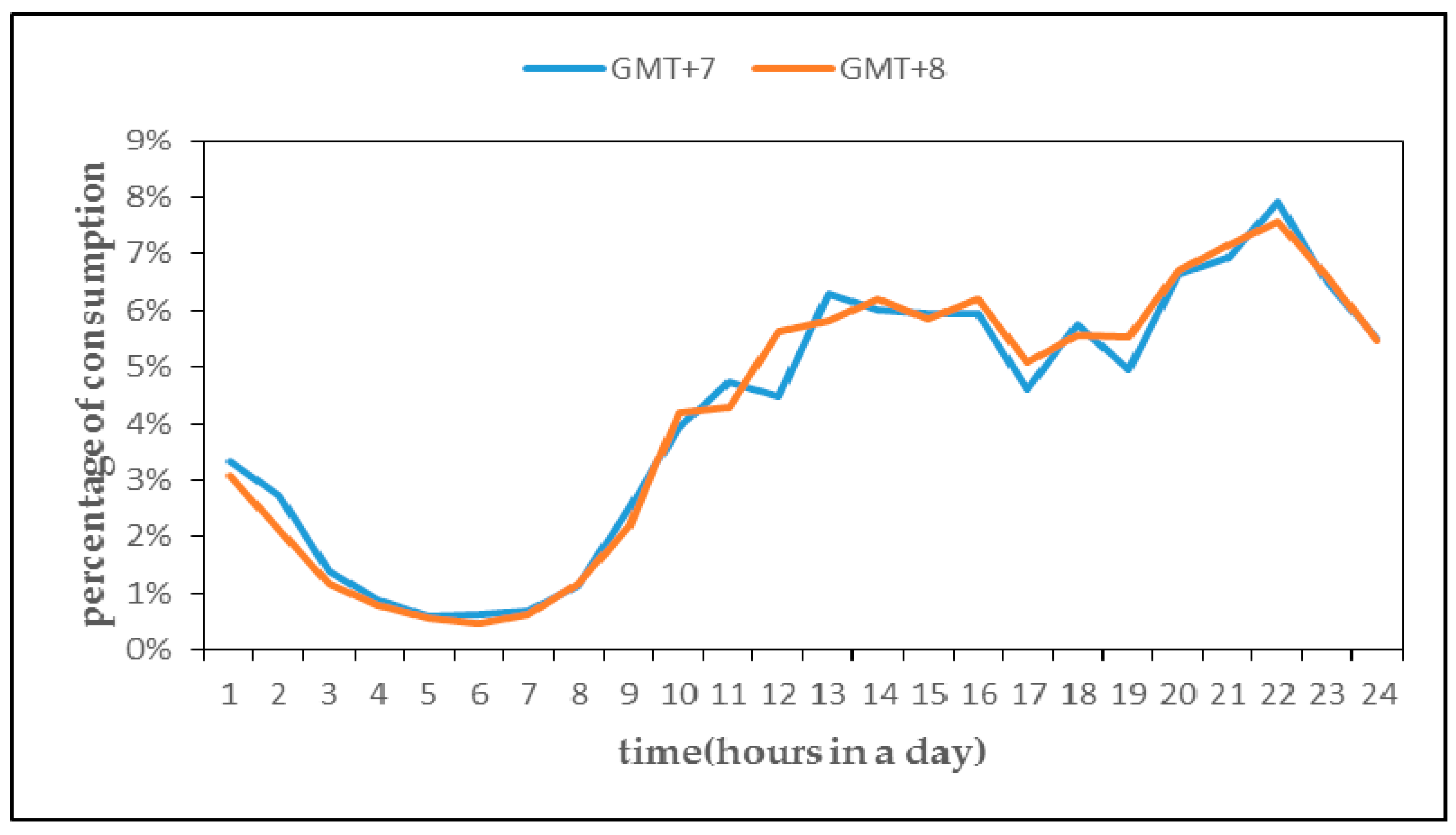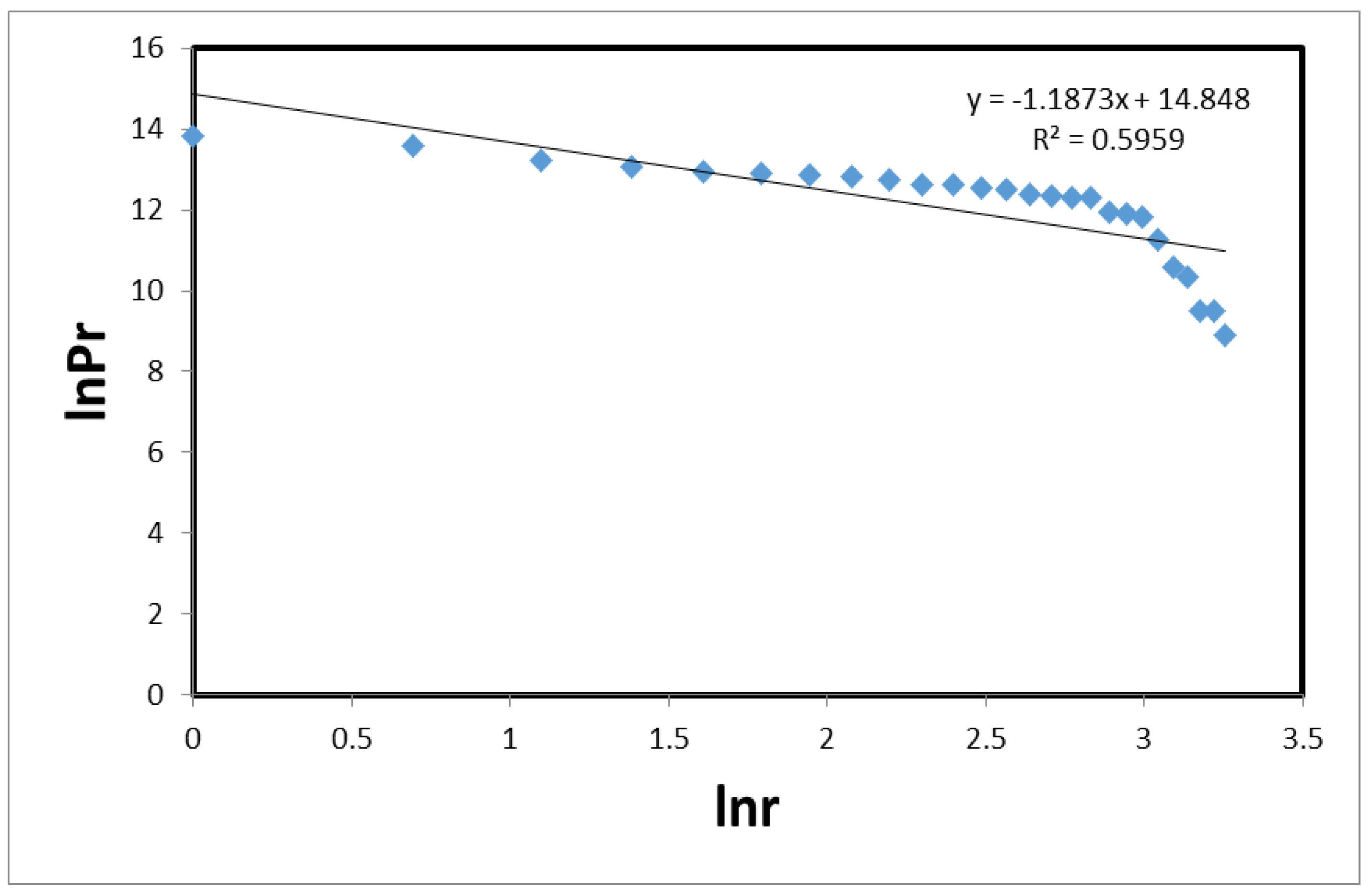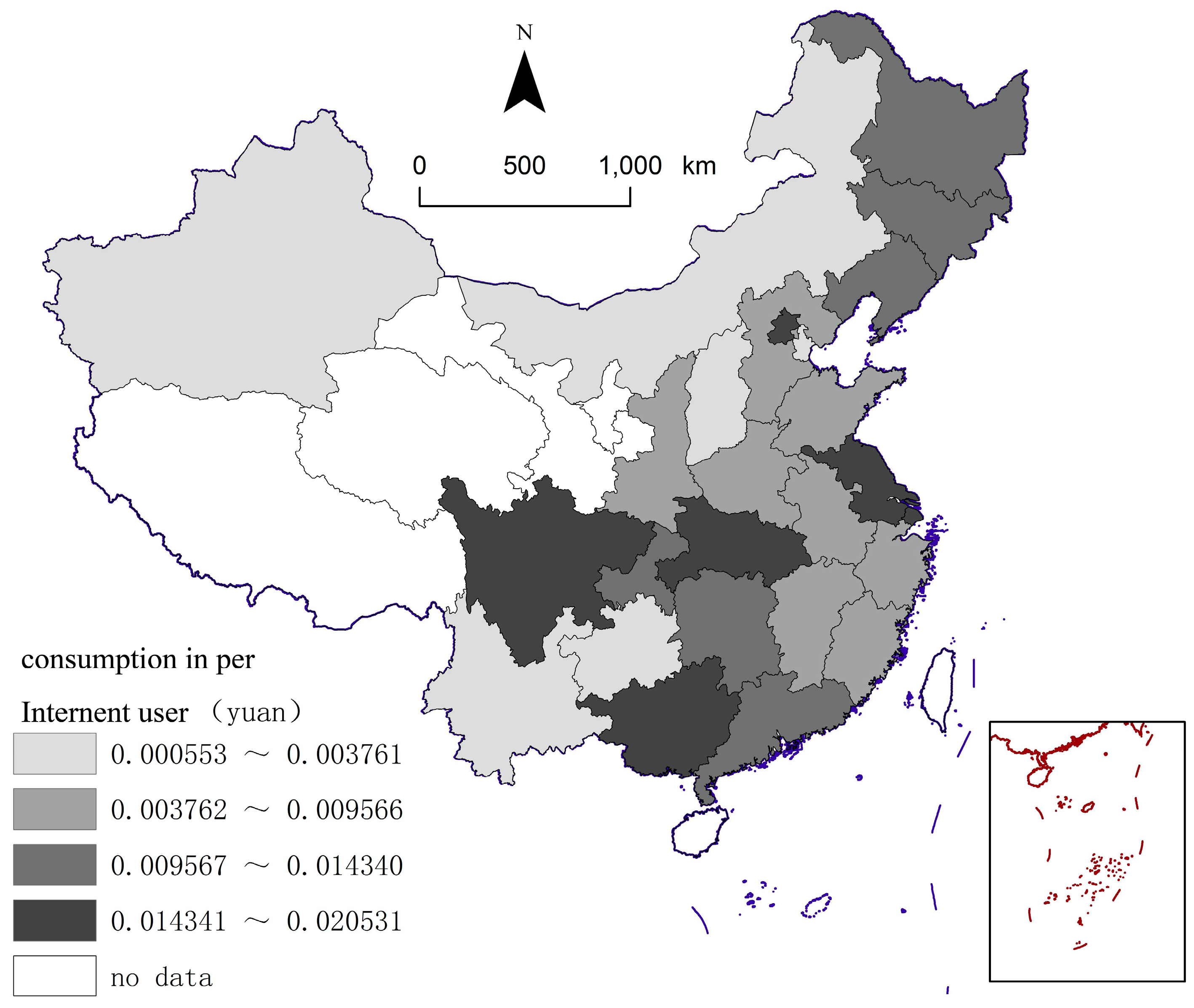Evolution and Transformation of the Central Place Theory in E-Business: China’s C2C Online Game Marketing
Abstract
1. Introduction
- (1)
- What is the temporal and spatial characteristics of online game consumption?
- (2)
- What is the difference between virtual goods and physical goods from the perspective of central place theory?
- (1)
- To understand the temporal and space characteristics of online game consumption through quantitative analysis and provide reference for marketing operators.
- (2)
- To understand the applicability of central place theory in virtual goods.
2. Literature Review
2.1. Virtual Goods: Online Game Consume
2.1.1. Research Theory
2.1.2. Research Means
2.1.3. Research Perspective
2.1.4. Research Object
2.2. Central Place Theory
3. Research Methods and Data Sources
3.1. Research Object
3.2. Data Processing
3.3. Research Method
3.3.1. Centralization Index
3.3.2. Zipf Rank-Size Rule
4. Analysis of the Differences of Time and Space in Online Game Consumption
4.1. Online Game Consumption Time Characteristics
4.1.1. National Online Game Consumption Time Characteristics
4.1.2. Changes in Consumption Time of Online Game in Various Province-Level Regions
4.1.3. Difference of Time Zone
4.2. Chinese Online Game Consumption Space Characteristics
4.2.1. Grade Size Characteristic
4.2.2. Characteristic of Consumption Status
4.2.3. Basic Pattern of Online Game Consumption
4.2.4. Online Game Consumption in Per Capita
5. Driving Mechanism for Online Game Virtual Goods Based on Central Place Theory
5.1. Transmission and Production Capacity
5.2. Consumption Ability
5.3. Consumer Group
5.4. Means of Consumption
6. Discussion and Conclusions
6.1. Discussion
6.2. Conclusions
Author Contributions
Funding
Acknowledgments
Conflicts of Interest
References
- Levitt, S.D.; List, J.A.; Neckermann, S.; Nelson, D. Quantity discounts on a virtual good: The results of a massive pricing experiment at King Digital Entertainment. Proc. Natl. Acad. Sci. USA 2016, 113, 7323–7328. [Google Scholar] [CrossRef]
- Park, B.W.; Lee, K.C. Exploring the value of purchasing online game items. Comput. Hum. Behav. 2011, 27, 2178–2185. [Google Scholar] [CrossRef]
- Hamari, J. Why do people buy virtual goods? Attitude toward virtual good purchases versus game enjoyment. Int. J. Inf. Manag. 2015, 35, 299–308. [Google Scholar] [CrossRef]
- Wang, W.T.; Chang, W.H. A study of virtual product consumption from the expectancy disconfirmation and symbolic consumption perspectives. Inf. Syst. Front. 2014, 16, 887–908. [Google Scholar] [CrossRef]
- Lehdonvirta, V. Virtual item sales as a revenue model: Identifying attributes that drive purchase decisions. Electron. Commer. Res. 2009, 9, 97–113. [Google Scholar] [CrossRef]
- Drachen, A.; Riley, J.; Baskin, S.; Klabjan, D. Going out of business: Auction house behavior in the massivelymulti-player online game glitch. Entertain. Comput. 2014, 5, 219–232. [Google Scholar] [CrossRef]
- Bloomfield, R.J.; Cho, Y.J. Unregulated stock markets in Second Life. South. Econ. J. 2011, 78, 6–29. [Google Scholar] [CrossRef]
- Castronova, E. Real Products in Imaginary Worlds. Harv. Bus. Rev. 2005, 83, 20–21. [Google Scholar]
- Castronova, E. On the Research Value of Large Games: Natural Experiments in Norrath and Camelo. Games Cult. 2006, 1, 163–186. [Google Scholar] [CrossRef]
- Seo, Y. Professionalized consumption and identity transformations in the field of eSports. J. Bus. Res. 2016, 69, 264–272. [Google Scholar] [CrossRef]
- Hamari, J.; Keronen, L. Why do people buy virtual goods: A meta-analysis. Comput. Hum. Behav. 2017, 71, 59–69. [Google Scholar] [CrossRef]
- Castronova, E.; Bell, M.W.; Cornell, R.; Cummings, J.; Emigh, W.; Falk, M.; Fatten, M.; LaFourest, P.; Mishler, N. A Test of the Law of Demand in a Virtual World: Exploring the Petri Dish Approach to Social Science. Int. J. Gaming Comput. Mediat. Simul. 2009, 1, 1–16. [Google Scholar] [CrossRef]
- Marchand, A.; Hennig-Thurau, T. Value Creation in the Video Game Industry: Industry Economics, Consumer Benefits, and Research Opportunities. J. Interact. Mark. 2013, 27, 141–157. [Google Scholar] [CrossRef]
- Seo, Y. Electronic sports: A new marketing landscape of the experience economy. J. Mark. Manag. 2013, 29, 1542–1560. [Google Scholar] [CrossRef]
- Thomes; Paul, T. In-house publishing and competition in the video game industry. Inf. Econ. Policy 2015, 32, 46–57. [Google Scholar] [CrossRef]
- Davidovicinora, M. Paid and Free Digital Business Models Innovations in the Video Game Industry. Digiworld Econ. J. 2014, 2, 83–102. [Google Scholar]
- Buchanan-Oliver, M.; Seo, Y. Play as co-created narrative in computer game consumption: The hero’s journey in Warcraft III. J. Consum. Behav. 2012, 11, 423–431. [Google Scholar] [CrossRef]
- Tao, W.; Hua, W.; Zongkui, Z.; Nan, C.; Lan, X.; Can, H. The Influence Factors of Online Game Consumption. J. Psychol. Sci. 2015, 38, 1482–1488. [Google Scholar]
- Yao, Y.; Chang, V. Towards Trust and Trust Building in a Selected Cloud Gaming Virtual Community. Int. J. Organ. Collect. Intell. 2014, 4, 64–86. [Google Scholar] [CrossRef]
- Mäntymäki, M.; Islam, A.K.M.N. Social virtual world continuance among teens: Uncovering the moderating role of perceived aggregate network exposure. Behav. Inf. Technol. 2014, 33, 536–547. [Google Scholar] [CrossRef]
- Mäntymäki, M.; Salo, J. Purchasing behavior in social virtual worlds: An examination of Habbo Hotel. Int. J. Inf. Manag. 2013, 33, 282–290. [Google Scholar] [CrossRef]
- Hamari, J.; Keronen, L. Why do people play games? A meta-analysis. Int. J. Inf. Manag. 2017, 37, 125–141. [Google Scholar] [CrossRef]
- Alha, K.; Koskinen, E.; Paavilainen, J.; Hamari, J. Why do people play location-based augmented reality games: A study on Pokemon GO. Comput. Hum. Behav. 2019, 93, 114–122. [Google Scholar] [CrossRef]
- Huang, E. Online experiences and virtual goods purchase intention. Internet Res. 2012, 22, 252–274. [Google Scholar] [CrossRef]
- Seo, Y.; Buchanan-Oliver, M.; Fam, K.S. Advancing research on computer game consumption: A future research agenda. J. Consum. Behav. 2015, 14, 353–356. [Google Scholar] [CrossRef]
- Rothmund, T.; Klimmt, C.; Gollwitzer, M. Low Temporal Stability of Excessive Video Game Use in German Adolescents. J. Media Psychol. 2015, 30, 53–65. [Google Scholar] [CrossRef]
- Choi, Y.K.; Yoon, S.; Taylor, C.R. How character presence in advergames affects brand attitude and game performance: A cross-cultural comparison. J. Consum. Behav. 2015, 14, 357–365. [Google Scholar] [CrossRef]
- Kuss, D.J.; Griffiths, M.D. Internet Gaming Addiction: A Systematic Review of Empirical Research. Int. J. Ment. Health Addict. 2012, 10, 278–296. [Google Scholar] [CrossRef]
- Wei, L.; Zhang, S.; Turel, O.; Bechara, A.; He, Q. A Tripartite Neurocognitive Model of internet Gaming Disorder. Front. Psychiatry 2017, 8, 1–11. [Google Scholar] [CrossRef]
- Morschheuser, B.; Riar, M.; Hamari, J.; Maedchea, A. How games induce cooperation? A study on the relationship between game features and we-intentions in an augmented reality game. Comput. Hum. Behav. 2017, 77, 169–183. [Google Scholar] [CrossRef]
- Sjoblom, M.; Hamari, J. Why do people watch others play video games? An empirical study on the motivations of Twitch users. Comput. Hum. Behav. 2017, 75, 985–996. [Google Scholar] [CrossRef]
- Castronova, E.; Knowles, I.; Ross, T.L. Policy questions raised by virtual economies. Telecommun. Policy 2015, 39, 787–795. [Google Scholar] [CrossRef]
- Castronova, E.; Williams, D.; Shen, C.; Ratan, R.; Xiong, L.; Huang, Y.; Keegan, B. As Real as Real? Macroeconomic Behavior in a Large-Scale Virtual World. New Media Soc. 2009, 11, 685–707. [Google Scholar] [CrossRef]
- Castronova, E. The Right to Play. N. Y. Law Sch. Law Rev. 2005, 49, 185–210. [Google Scholar]
- Ying, Y. Progress in commercial spatial studies in western countries since the 1920s. Trop. Geogr. 2000, 20, 62–66. [Google Scholar]
- Chunshan, Z.; Yan, L.; Yanran, S. Research progress of commercial geography in china. Acta Geogr. Sin. 2004, 59, 1028–1036. [Google Scholar]
- Huayou, Z. Research on urban retailing’s microlocation selection and competitiveness—Take wal-mart retail business in jinhua as an example. China Bus. Mark. 2009, 23, 55–58. [Google Scholar]
- Wuyang, Y.; Qi, Y. On the areal structure of urban settlements. Geogr. Res. 1986, 5, 1–11. [Google Scholar]
- Yishao, S. The historical development and geographical distribution of fairs in China. Geogr. Res. 1999, 18, 318–326. [Google Scholar]
- Shangyi, Z.; Limei, J. Commercial Space Succession in Old City of Beijing Case of Survey Line of Inner City in Beijing from 1996 to 2006. Sci. Geogr. Sin. 2009, 29, 493–499. [Google Scholar]
- Ling, X.; Baiyu, L.; Jin, W. Dynamic simulation of central place by using agent-based modeling. Geogr. Res. 2010, 7, 46–49. [Google Scholar]
- Wei, Z.; De, W. Multi-agent Based Simulation of Retail Spatial Structure. Acta Geogr. Sin. 2011, 66, 796–804. [Google Scholar]
- Runjiao, L.; Lei, S.; Difei, J. Using Multi-agent Simulation Method to Verify the Space Structure of Central Place Theory. Geogr. Geo-Inf. Sci. 2016, 32, 18–24. [Google Scholar]
- South, R.; Boots, B. Relaxing the nearest centre assumption in central place theory. Pap. Reg. Sci. 2005, 78, 157–177. [Google Scholar] [CrossRef]
- Barton, B. The creation of centrality. Ann. Assoc. Am. Geogr. 1978, 68, 34–44. [Google Scholar] [CrossRef]
- Mäntymäki, M.; Salo, J. Why do teens spend real money in virtual worlds? A consumption values and developmental psychology perspective on virtual consumption. Int. J. Inf. Manag. 2015, 35, 124–134. [Google Scholar] [CrossRef]
- Rui, L.; Dianting, W.; Jie, B.; Yan, Q.; Wei, W. Evolution of temporal and spatial pattern and driving mechanisms of agglomerative growth of senior science talents: A case study of academicians of CAS. Prog. Geogr. 2013, 32, 1123–1138. [Google Scholar]
- Dingquan, Y.; Qunyuan, C. Study on the size—Distribution of urban system inhunan province based on the fractal theory. Econ. Geogr. 2006, 26, 245–248. [Google Scholar]
- Guoliang, Y.; Jie, Z.; Nanshan, A.; Bo, L. Zip Structure and Difference Degree of Tourist Flow Size System: A Caes Study of Sichuan Province. Acta Geogr. Sin. 2006, 61, 1281–1289. [Google Scholar]
- Kunbo, S.; Yongchun, Y.; Qiang, R.; Run, L.; Qingnan, Y.; Rui, Z. Study on spatial pattern and spatial mismatch of experiential online group-buying market in China. Prog. Geogr. 2015, 34, 696–706. [Google Scholar]
- Yinghan, T. A Spatial Difference Study on China’s E-Commerce Development Level. Econ. Geogr. 2015, 35, 9–14. [Google Scholar]
- Hamari, J.; Hanner, N.; Koivisto, J. Service quality explains why people use freemium services but not if they go premium: An empirical study in free-to-play games. Int. J. Inf. Manag. 2017, 37, 1449–1459. [Google Scholar] [CrossRef]
- Hamari, J.; Alha, K.; Järvelä, S.; Kivikangas, J.M. Why do players buy in-game content? An empirical study on concrete purchase motivations. Comput. Hum. Behav. 2017, 68, 538–546. [Google Scholar] [CrossRef]







| Peak Season | Off Season | |||||||||
|---|---|---|---|---|---|---|---|---|---|---|
| Province-Level Region | 00:00 –06:00 | 06:00 –12:00 | 12:00 –18:00 | 18:00 –00:00 | I | 00:00 –06:00 | 06:00 –12:00 | 12:00 –18:00 | 18:00 –00:00 | I |
| Guangdong | 11.65 | 15.10 | 34.29 | 38.96 | 32.69 | 12.44 | 18.01 | 31.03 | 38.52 | 31.38 |
| Beijing | 7.59 | 16.72 | 33.28 | 42.41 | 37.03 | 6.80 | 17.65 | 33.42 | 42.14 | 38.66 |
| Sichuan | 10.12 | 16.26 | 35.80 | 37.81 | 32.97 | 9.34 | 16.36 | 35.88 | 38.42 | 34.59 |
| Jiangsu | 3.87 | 16.38 | 35.18 | 39.94 | 33.01 | 7.24 | 17.23 | 34.00 | 41.52 | 36.57 |
| Hubei | 8.29 | 15.67 | 35.95 | 40.08 | 36.71 | 9.95 | 19.34 | 31.03 | 39.68 | 33.10 |
| Guangxi | 6.74 | 19.29 | 33.77 | 37.67 | 31.28 | 10.31 | 20.94 | 31.86 | 36.89 | 29.15 |
| Zhejiang | 4.51 | 18.55 | 34.72 | 42.21 | 38.78 | 7.83 | 18.81 | 36.35 | 37.01 | 35.37 |
| Shandong | 5.80 | 18.07 | 34.28 | 41.86 | 38.34 | 9.27 | 22.50 | 32.35 | 35.88 | 28.78 |
| Shanghai | 9.68 | 15.43 | 33.05 | 41.85 | 35.27 | 6.52 | 17.41 | 36.68 | 39.39 | 38.68 |
| Anhui | 9.00 | 14.74 | 40.07 | 36.19 | 36.51 | 6.64 | 22.86 | 33.63 | 36.87 | 37.88 |
| Hebei | 6.65 | 19.90 | 33.90 | 39.55 | 35.84 | 7.64 | 19.22 | 31.30 | 41.84 | 39.54 |
| Liaoning | 7.26 | 19.28 | 36.33 | 37.13 | 33.37 | 5.11 | 20.45 | 37.80 | 36.64 | 36.33 |
| Fujian | 12.13 | 15.52 | 35.83 | 36.52 | 32.70 | 8.06 | 23.49 | 33.48 | 34.97 | 32.74 |
| Chongqing | 13.65 | 15.98 | 37.19 | 33.18 | 33.27 | 11.42 | 16.69 | 33.16 | 38.73 | 35.73 |
| Heilongjiang | 7.14 | 19.14 | 37.14 | 36.57 | 34.61 | 8.28 | 20.43 | 38.67 | 32.62 | 33.36 |
| Jiangxi | 8.03 | 17.01 | 35.31 | 39.65 | 36.80 | 10.14 | 21.47 | 36.77 | 31.62 | 37.63 |
| Shaanxi | 10.37 | 16.92 | 32.22 | 40.49 | 35.61 | 12.08 | 19.64 | 34.08 | 34.20 | 29.07 |
| Jiling | 4.28 | 21.89 | 37.43 | 36.40 | 40.35 | 11.40 | 19.96 | 33.13 | 35.51 | 35.21 |
| Shanxi | 9.87 | 17.16 | 33.45 | 39.53 | 42.41 | 8.28 | 23.89 | 32.99 | 34.83 | 44.08 |
| Tianjin | 4.90 | 20.84 | 33.25 | 41.01 | 51.08 | 2.50 | 14.09 | 36.98 | 46.42 | 58.48 |
| Henan | 8.03 | 19.59 | 35.80 | 36.57 | 34.59 | 7.26 | 20.28 | 36.40 | 36.06 | 31.82 |
| Hunan | 8.19 | 14.97 | 36.16 | 40.68 | 37.24 | 8.92 | 18.60 | 34.05 | 38.42 | 36.62 |
| Xinjiang | 12.71 | 11.59 | 39.93 | 35.77 | 59.25 | 10.19 | 0.00 | 37.84 | 51.97 | 69.16 |
| Inner Mongolia | 3.98 | 25.54 | 28.48 | 42.00 | 63.97 | 0.00 | 3.91 | 42.72 | 53.38 | 70.65 |
| Guizhou | 5.73 | 25.28 | 33.62 | 35.37 | 46.93 | 7.99 | 14.60 | 22.65 | 54.76 | 48.51 |
| Yunnan | 4.14 | 15.06 | 29.16 | 51.65 | 54.02 | 6.60 | 20.25 | 25.35 | 47.80 | 55.86 |
| Status | Province-Level Region |
|---|---|
| High peak season and high off season | Guangdong, Jiangsu, Sichuan, Hubei, Hunan, Guangxi, Henan, Shanghai, Zhejiang, Shandong, and Liaoning, |
| High peak season and low off season | Hebei |
| Low peak season and low off season | Beijing, Heilongjiang, and Anhui, Chongqing, Fujian, Jilin, Jiangxi, Shaan xi, Shan xi, Guizhou, Tianjin, Xinjiang, Yunnan, and Inner Mongolia |
| Low peak season and high off seasons | None |
| Influencing Factors | Peak Season | Off Season | Average |
|---|---|---|---|
| business volume of telecommunication services (X1) | 0.843 ** | 0.861 ** | 0.853 ** |
| total retail sales of consumer goods (X2) | 0.830 ** | 0.822 ** | 0.828 ** |
| GDP (X3) | 0.829 ** | 0.820 ** | 0.827 ** |
| number of Internet users (X4) | 0.828 ** | 0.833 ** | 0.832 ** |
| number of regular students enrolled in normal and short-cycle courses (X5) | 0.740 ** | 0.717 ** | 0.732 ** |
| sales of e-commerce (X6) | 0.570 ** | 0.592 ** | 0.581 ** |
| purchases of e-commerce (X7) | 0.601 ** | 0.632 ** | 0.616 ** |
© 2019 by the authors. Licensee MDPI, Basel, Switzerland. This article is an open access article distributed under the terms and conditions of the Creative Commons Attribution (CC BY) license (http://creativecommons.org/licenses/by/4.0/).
Share and Cite
Li, Q.; Liu, Q.; Guo, X.; Xu, S.; Liu, J.; Lu, H. Evolution and Transformation of the Central Place Theory in E-Business: China’s C2C Online Game Marketing. Sustainability 2019, 11, 2274. https://doi.org/10.3390/su11082274
Li Q, Liu Q, Guo X, Xu S, Liu J, Lu H. Evolution and Transformation of the Central Place Theory in E-Business: China’s C2C Online Game Marketing. Sustainability. 2019; 11(8):2274. https://doi.org/10.3390/su11082274
Chicago/Turabian StyleLi, Qiang, Qing Liu, Xiaona Guo, Shuo Xu, Jingyu Liu, and Heli Lu. 2019. "Evolution and Transformation of the Central Place Theory in E-Business: China’s C2C Online Game Marketing" Sustainability 11, no. 8: 2274. https://doi.org/10.3390/su11082274
APA StyleLi, Q., Liu, Q., Guo, X., Xu, S., Liu, J., & Lu, H. (2019). Evolution and Transformation of the Central Place Theory in E-Business: China’s C2C Online Game Marketing. Sustainability, 11(8), 2274. https://doi.org/10.3390/su11082274





